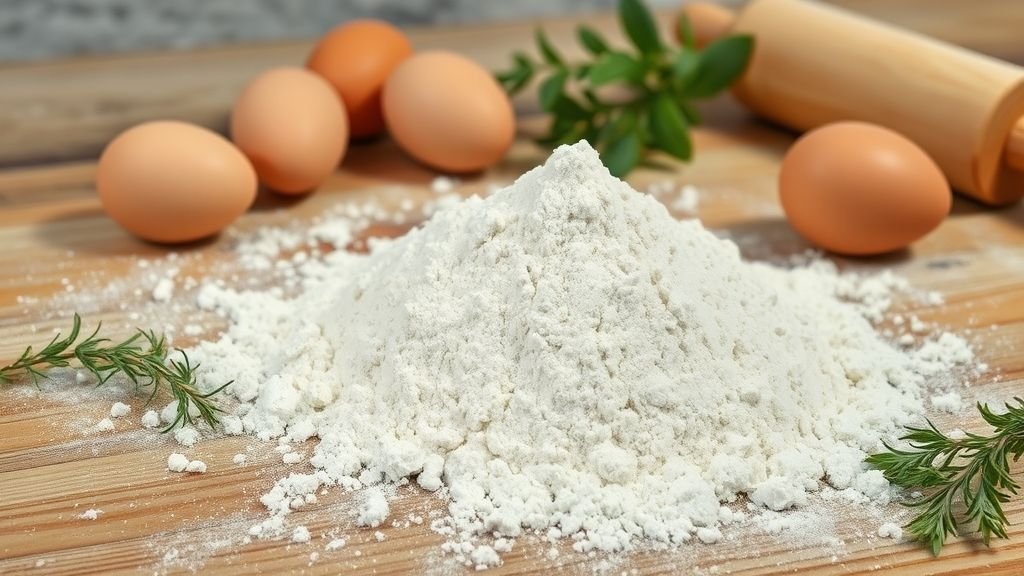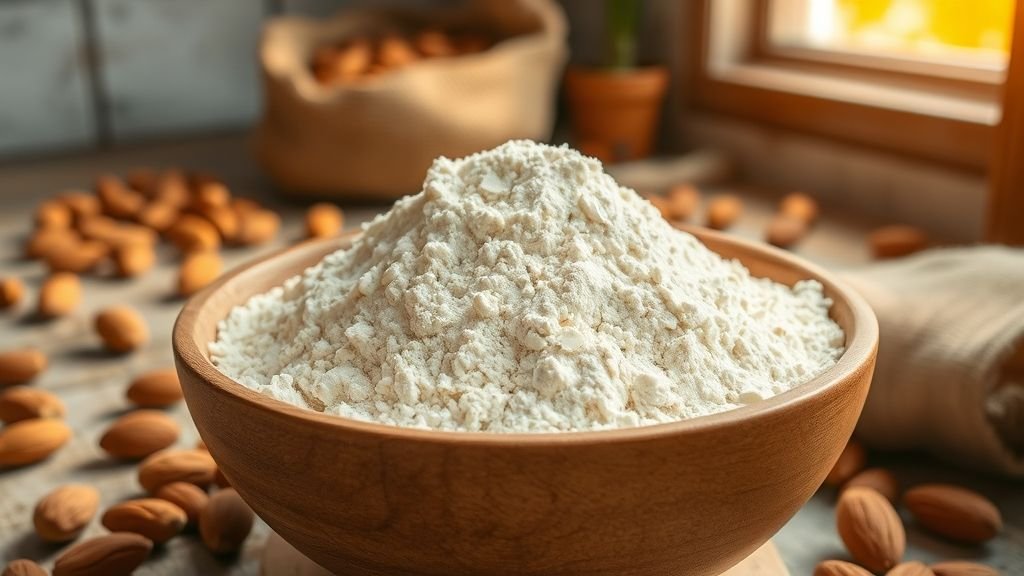
If you’ve recently gone gluten-free, you’re not alone. Millions are making the shift due to celiac disease, gluten sensitivity, or simply for better gut health. But if you’ve ever tried baking without wheat, you’ve probably asked yourself: “Which gluten free flour is best for baking?” It’s a fair question—and an important one, especially if you’re craving that perfect loaf of gluten free bread that’s not dry, dense, or bland.
In this guide, we’ll explore the best options for gluten free flour for baking, from versatile blends to specialty flours that shine in specific recipes. Whether you’re baking cookies or crafting artisan bread, you’ll find options that suit your kitchen, your diet, and your taste buds.
We’ll also share real-world insights, a few expert tips, and even data-backed recommendations to help you feel confident every time you preheat the oven.
1. Understanding Gluten Free Flour: What Makes It Work?
Before diving into our top picks, let’s understand what makes gluten free flour for baking unique. Traditional wheat flour contains gluten—a protein that gives dough its elasticity and structure. Without it, you need a substitute that replicates those properties.
That’s why most gluten free flours are either:
-
Single-origin flours (like almond, coconut, or rice flour), or
-
Blended mixes, which often include starches (like tapioca or potato starch) and gums (like xanthan gum) to mimic gluten’s role.
The trick is finding the right balance for your recipe. For example, the flour you use for baking a fluffy cake won’t be the same as what you need for dense, chewy bread.
👉 Pro Tip: Many successful gluten free bakers mix their own flour blends for better results. We’ll cover that in a bit.
2. Best Gluten Free Flour for Bread Baking
Baking gluten free bread can feel like a science experiment—but it doesn’t have to. When aiming for structure and rise in your loaf, not all flours are created equal. Here’s a breakdown of the best performers:
1. Sorghum Flour
-
Mild, slightly sweet flavor
-
High in protein and fiber
-
Works well in gluten free flour blends for bread
2. Teff Flour
-
Commonly used in Ethiopian injera
-
Great for a nutty flavor and soft crumb
-
High in nutrients like iron and calcium
3. Brown Rice Flour
-
Neutral flavor
-
Great base for custom flour blends
-
Pairs well with tapioca starch for elasticity
4. Tapioca Starch + Potato Starch (Blending Tip)
-
Neither works alone, but together, they mimic gluten’s bounce
-
Combine with brown rice or sorghum for great texture
📊 Original Insight: According to a 2023 Statista report, gluten free bread sales increased by 25% year-over-year in the U.S., signaling growing consumer demand—and innovation in flour blends is a major reason.
3. All-Purpose Gluten Free Flour Blends: The Busy Baker’s Best Friend
If you don’t have time to experiment, all-purpose gluten free flour for baking is your best bet. These pre-made blends are convenient and designed to replace wheat flour cup-for-cup.
Top Picks:
-
Bob’s Red Mill Gluten Free 1-to-1 Baking Flour
-
Includes xanthan gum
-
Works great for cakes, cookies, muffins
-
Not ideal for yeast bread—needs additional structure
-
-
King Arthur Measure for Measure Gluten Free Flour
-
No gritty texture
-
Balanced with whole grains
-
Performs well in brownies and quick breads
-
-
Cup4Cup Multipurpose Flour
-
Developed by chefs
-
Premium blend—excellent in pastries and pie crusts
-
Contains dairy (not suitable for vegan recipes)
-
✅ Case Study: A small café in Austin, Texas—Bread Without Borders—built its brand around using King Arthur’s gluten free blend for everything from sandwich loaves to scones. They credit the consistency of the flour for their loyal customer base and 5-star reviews on Yelp.
4. Choosing the Best Gluten Free Flour for Specific Recipes
Every baked good has different needs. Here’s a quick guide to help you pick the best gluten free flour for different types of baking:
1. For Bread:
-
Sorghum + Teff + Tapioca blend
-
Add psyllium husk or xanthan gum for structure
2. For Cakes & Cupcakes:
-
Rice flour or a commercial blend like Cup4Cup
-
Add extra moisture (e.g., yogurt or applesauce) to prevent dryness
3. For Cookies:
-
Almond flour or oat flour
-
Enhances flavor and chewiness
4. For Pancakes & Muffins:
-
Buckwheat or millet flour
-
Nutty flavor, great rise
5. For Pizza Crust:
-
Cassava + almond flour combo
-
Crispy, chewy texture
📌 Remember: Always read labels—some flours may be cross-contaminated with wheat unless labeled certified gluten free.
5. Pro Tips for Successful Gluten Free Baking
If you’re new to baking with gluten free flour for baking, here are a few strategies to help you avoid common pitfalls and improve your results:
1. Hydrate More Than Usual
Gluten free flours are thirstier than wheat flour. Let batters rest for 15–30 minutes before baking to hydrate the starches and reduce grittiness.
2. Don’t Skip Binders
Use xanthan gum, guar gum, or psyllium husk to replace gluten’s binding effect. Start with 1 tsp per cup of flour for yeast bread.
3. Mix Flours for Best Results
Avoid using just one type of flour unless a recipe specifies it. Blending gives you better texture, taste, and nutritional balance.
4. Weigh, Don’t Scoop
Use a digital scale instead of cups for more consistent results—especially important with variable-density flours like almond or coconut.
Bonus: Make Your Own Gluten Free Flour Blend
Here’s a tried-and-true gluten free blend recipe used by artisan bakers:
DIY All-Purpose Gluten Free Blend (Makes 4 Cups):
-
2 cups brown rice flour
-
2/3 cup potato starch
-
1/3 cup tapioca flour
-
1 tsp xanthan gum (optional)
➡️ This blend works well for muffins, cookies, and even pancakes. For bread, add 2 tbsp psyllium husk to enhance structure.
Conclusion: Elevate Your Baking with the Right Flour
Finding the right gluten free flour for baking can transform your kitchen from a place of frustration to a hub of delicious, reliable results. From baking sandwich bread with sorghum and teff to crafting cookies with almond flour or relying on convenient all-purpose blends, the options are richer than ever.
The key is to match the flour to the recipe, and don’t be afraid to experiment.
Ready to upgrade your gluten free baking game? Try one of the blends above or mix your own and enjoy the results.
🤔FAQs
1. What is the best gluten free flour for baking bread?
The best gluten free flour for baking bread is often a blend of sorghum flour, teff flour, and tapioca starch, paired with a binding agent like psyllium husk or xanthan gum. This combination helps create structure, elasticity, and moisture similar to wheat-based bread.
2. Can I use almond flour as a substitute for all-purpose flour?
Almond flour can work in some recipes, especially cookies, muffins, and pancakes, but it’s not a 1:1 substitute for wheat flour. It lacks the starch and binding properties needed for bread or structured baked goods unless combined with other gluten free flours.
3. Is gluten free flour healthier than regular flour?
Not necessarily. Gluten free flour is a better option for those with celiac disease or gluten intolerance, but not all gluten free options are more nutritious. Some are higher in carbs and lower in fiber. Choose whole grain-based flours like brown rice or buckwheat for a nutritional edge.
4. What gluten free flour is best for baking cakes?
Rice flour, millet flour, or all-purpose gluten free blends like Cup4Cup or King Arthur Measure for Measure work well for cakes. These flours offer a light texture and subtle flavor, perfect for sweet baked goods.
5. Can I bake gluten free without xanthan gum?
Yes, you can bake without xanthan gum by using alternatives like psyllium husk, chia seeds, or flaxseeds. These binders help replicate the elasticity of gluten and are especially useful in gluten free bread recipes.
6. What’s the difference between gluten free flour and wheat flour?
Wheat flour contains gluten, which gives baked goods their structure and chewiness. Gluten free flour is made from alternative grains, nuts, or starches and requires additional binders to mimic those properties.
7. Do gluten free flours expire faster?
Yes. Flours like almond, coconut, and brown rice flour can go rancid more quickly due to their natural oils. Always store gluten free flour in an airtight container in a cool, dark place or refrigerate for longer shelf life.
8. Can I make my own gluten free flour blend at home?
Absolutely! A simple DIY blend includes brown rice flour, potato starch, and tapioca flour. Add xanthan gum or psyllium husk if you’re baking bread. This allows you to control texture, flavor, and performance based on your needs.


